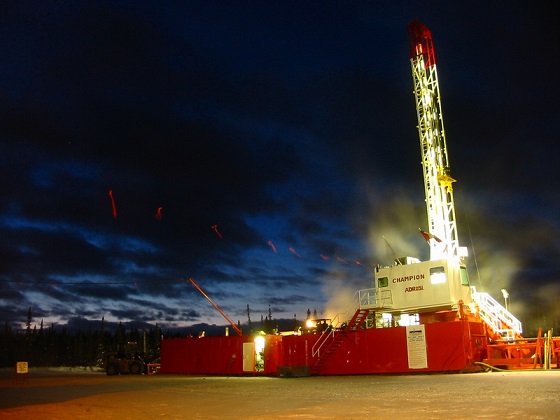Energy
Unlocking Canada’s energy potential

Resource Works CEO and founder Stewart Muir has laid out the conditions for Canada to realize its potential
How can Canada fully realize its energy potential?
Stewart Muir – CEO of Resource Works – often speaks about this question. According to Muir, Canada’s abundant natural resources, skilled workforce, and high standards give us a strong foundation to build on. But to translate these strengths into true economic and environmental leadership, a few key conditions must be met.
Below are five key conditions Muir highlights (especially regarding LNG and oil development) that can help Canada seize its energy opportunity:
Streamlined & Efficient Regulation – Unnecessarily lengthy and unpredictable approval processes have stalled projects and scared away investors. Muir advocates cutting red tape and speeding up decisions so that government isn’t working “at cross purposes” with industry . Reforming Canada’s permitting and regulatory processes would make energy projects more viable and globally competitive, allowing development to proceed faster without compromising standards.
Strong Indigenous Partnerships – Canada’s energy future needs to be built in true partnership with Indigenous peoples. Muir points out that First Nations are increasingly co-leading resource projects, with over 500 economic and reconciliation agreements in British Columbia alone. Embracing Indigenous leadership – through equity partnerships, consultations, and benefit-sharing – not only advances reconciliation but also creates certainty and shared prosperity for energy developments. Projects move forward best when Indigenous communities are on board as genuine partners.
Robust Infrastructure & Market Access – To capitalize on our resources, Canada must expand and modernize the infrastructure that gets energy to market. That means building and upgrading pipelines, ports, and LNG terminals. The recent completion of the Trans Mountain Expansion (TMX) pipeline is a proof point – it’s already moving Canadian oil to U.S. and Asian buyers , helping fetch better prices. Muir and others argue we also need to develop new LNG capacity, including on the East Coast, to supply allies in Europe . By investing in strategic infrastructure, Canada can ensure its oil and gas reach global markets efficiently and safely, turning resource potential into real economic growth.
Proactive Global Market Positioning – Canada has to seize its moment in the global energy market. Demand for energy is skyrocketing worldwide, yet Canada hasn’t fully stepped up to meet it. For example, when allied nations like Germany and Japan turned to Canada for LNG in recent years, they left empty-handed for lack of a “strong business case” to export gas. Meanwhile, other suppliers (the U.S., Qatar, etc.) eagerly filled those needs. Muir emphasizes that Canada must proactively position itself as a reliable exporter – or risk being left behind while others grab the opportunity. That means securing long-term contracts and building trade relationships so Canadian LNG and oil can become go-to choices in Asia, Europe, and beyond. In short, we need to act with urgency on the world stage to claim our share of the market.
Public Confidence through Environmental Leadership – Earning public trust is essential for any energy project to succeed. Canadians need to see that resource development can coexist with high environmental standards and climate responsibility. Muir notes that strengthening public confidence in energy and mining projects could help “preserve and unlock” the economic value of Canada’s huge reserves, and even position Canada as a leader in how to do resource development right. This means being transparent, engaging communities early, and upholding world-class environmental protections. Canada’s own track record shows that responsible resource development is not just possible – “it’s our forte”. By leading with strong environmental performance (for instance, using clean technology and cutting emissions per barrel), project developers can build the social license to operate. In turn, this public trust enables more projects to move ahead, aligning economic growth with our climate and environmental commitments.
Bottom Line: Muir’s vision suggests that if Canada delivers on these conditions – from faster approvals and better partnerships to smarter infrastructure and trust-building – we can translate our natural advantages into both prosperity and sustainability. Canada has the resources and know-how; now it’s about having the will to act.
By focusing on these key areas, Canada can become not only an energy powerhouse at home, but also a global example of economic and environmental leadership in responsible energy development.
2025 Federal Election
Mark Carney Wants You to Forget He Clearly Opposes the Development and Export of Canada’s Natural Resources

From Energy Now
At COP26, Mark Carney also said that he thinks “we have both far far too many fossil fuels in the world” and “as much as half of oil reserves, proven oil reserves need to stay in the ground” climate goals.
Mark Carney claims that he supports Canada’s oil and gas industry and wants to see Canada export more of our natural resources. But Carney is yet again lying.
If Carney was sincere, he would immediately commit to the full repeal of the Liberals’ C-69, the ‘No More Pipelines’ Act, C-48, the West Coast Tanker Ban, and the production cap. Instead he doubled down on capping Canadian energy production.
But it’s not just that, Mark Carney has a clear history of opposing Canadian energy and infrastructure projects in favour of his radical anti-energy ideology and his goal of shutting down Canadian energy production.
However, while deliberately fighting against Canadian energy, this high flying hypocrite was having his company, Brookfield Asset Management, invest in some of the largest global pipeline projects in Brazil and the United Arab Emirates.
When asked by Conservative Party Leader Pierre Poilievre at an Industry Committee meeting, if he supported Justin Trudeau’s decision to veto the Northern Gateway pipeline, Mark Carney said “given both environmental and commercial reasons … I think it’s the right decision.”
Then, just six months later at COP26, Mark Carney also said that he thinks “we have both far far too many fossil fuels in the world” and “as much as half of oil reserves, proven oil reserves need to stay in the ground” climate goals.
If this wasn’t enough Mark Carney has now teamed up with Trudeau’s radical anti-energy ministers to finish off Canada’s energy sector, a goal that he has outlined while attending a World Economic Forum event in Davos.
Starting with the radical, self-proclaimed socialist, Steven Guilbeault, who’s history of anti-energy and infrastructure policies is all too familiar to Canadians.
Mark Carney has enabled Steven Guilbeault to do even more damage by promoting him to his Quebec Lieutenant, giving him three new ministerial responsibilities so he can continue his climate crusade against Canadian energy and infrastructure projects.
Canadians remember when Guilbeault said that “I disagree with the [Trans Mountain] pipeline” and that “Canada shouldn’t be investing in new infrastructure for fossil fuels.”
They also remember when he proudly proclaimed that “Our government has made the decision to stop investing in new road infrastructure.” All from a minister who shamed Canadians for owning cars.
Then there is the pipeline hating Jonathan Wilkinson, who Carney appointed as Canada’s Minister of Energy and Natural Resources. Recently, Wilkinson wrote a scathing letter to Canada’s energy leaders for their opposition to the Carney-Trudeau Liberals production cap on Canadian oil and gas.
Despite Canadian industries being subject to unjustified tariffs from the United States, Jonathan Wilkinson recently told reporters that “Everybody’s sort of running around saying, ‘Oh my God, we need a new pipeline, we need a new pipeline.’ The question is, well, why do we need a new pipeline?”
Finally, there is Carney’s new Minister of Environment and Climate Change Terry Duguid. Duguid has doubled down on Mark Carney’s climate radicalism by stating that “a Mark Carney government will maintain the cap on emissions from the production of oil and gas”.
From 2015 to 2021 Carney-Trudeau environmental and anti-industry policies have cancelled over $176 billion in Canadian energy projects, with many more being cancelled afterwards. That means $176 billion worth of jobs and powerful paycheques have been blocked from Canadians so Mark Carney and his Ministers can impose their radical net zero ideology.
Bjorn Lomborg
Net zero’s cost-benefit ratio is CRAZY high

From the Fraser Institute
The best academic estimates show that over the century, policies to achieve net zero would cost every person on Earth the equivalent of more than CAD $4,000 every year. Of course, most people in poor countries cannot afford anywhere near this. If the cost falls solely on the rich world, the price-tag adds up to almost $30,000 (CAD) per person, per year, over the century.
Canada has made a legal commitment to achieve “net zero” carbon emissions by 2050. Back in 2015, then-Prime Minister Trudeau promised that climate action will “create jobs and economic growth” and the federal government insists it will create a “strong economy.” The truth is that the net zero policy generates vast costs and very little benefit—and Canada would be better off changing direction.
Achieving net zero carbon emissions is far more daunting than politicians have ever admitted. Canada is nowhere near on track. Annual Canadian CO₂ emissions have increased 20 per cent since 1990. In the time that Trudeau was prime minister, fossil fuel energy supply actually increased over 11 per cent. Similarly, the share of fossil fuels in Canada’s total energy supply (not just electricity) increased from 75 per cent in 2015 to 77 per cent in 2023.
Over the same period, the switch from coal to gas, and a tiny 0.4 percentage point increase in the energy from solar and wind, has reduced annual CO₂ emissions by less than three per cent. On that trend, getting to zero won’t take 25 years as the Liberal government promised, but more than 160 years. One study shows that the government’s current plan which won’t even reach net-zero will cost Canada a quarter of a million jobs, seven per cent lower GDP and wages on average $8,000 lower.
Globally, achieving net-zero will be even harder. Remember, Canada makes up about 1.5 per cent of global CO₂ emissions, and while Canada is already rich with plenty of energy, the world’s poor want much more energy.
In order to achieve global net-zero by 2050, by 2030 we would already need to achieve the equivalent of removing the combined emissions of China and the United States — every year. This is in the realm of science fiction.
The painful Covid lockdowns of 2020 only reduced global emissions by about six per cent. To achieve net zero, the UN points out that we would need to have doubled those reductions in 2021, tripled them in 2022, quadrupled them in 2023, and so on. This year they would need to be sextupled, and by 2030 increased 11-fold. So far, the world hasn’t even managed to start reducing global carbon emissions, which last year hit a new record.
Data from both the International Energy Agency and the US Energy Information Administration give added cause for skepticism. Both organizations foresee the world getting more energy from renewables: an increase from today’s 16 per cent to between one-quarter to one-third of all primary energy by 2050. But that is far from a transition. On an optimistically linear trend, this means we’re a century or two away from achieving 100 percent renewables.
Politicians like to blithely suggest the shift away from fossil fuels isn’t unprecedented, because in the past we transitioned from wood to coal, from coal to oil, and from oil to gas. The truth is, humanity hasn’t made a real energy transition even once. Coal didn’t replace wood but mostly added to global energy, just like oil and gas have added further additional energy. As in the past, solar and wind are now mostly adding to our global energy output, rather than replacing fossil fuels.
Indeed, it’s worth remembering that even after two centuries, humanity’s transition away from wood is not over. More than two billion mostly poor people still depend on wood for cooking and heating, and it still provides about 5 per cent of global energy.
Like Canada, the world remains fossil fuel-based, as it delivers more than four-fifths of energy. Over the last half century, our dependence has declined only slightly from 87 per cent to 82 per cent, but in absolute terms we have increased our fossil fuel use by more than 150 per cent. On the trajectory since 1971, we will reach zero fossil fuel use some nine centuries from now, and even the fastest period of recent decline from 2014 would see us taking over three centuries.
Global warming will create more problems than benefits, so achieving net-zero would see real benefits. Over the century, the average person would experience benefits worth $700 (CAD) each year.
But net zero policies will be much more expensive. The best academic estimates show that over the century, policies to achieve net zero would cost every person on Earth the equivalent of more than CAD $4,000 every year. Of course, most people in poor countries cannot afford anywhere near this. If the cost falls solely on the rich world, the price-tag adds up to almost $30,000 (CAD) per person, per year, over the century.
Every year over the 21st century, costs would vastly outweigh benefits, and global costs would exceed benefits by over CAD 32 trillion each year.
We would see much higher transport costs, higher electricity costs, higher heating and cooling costs and — as businesses would also have to pay for all this — drastic increases in the price of food and all other necessities. Just one example: net-zero targets would likely increase gas costs some two-to-four times even by 2030, costing consumers up to $US52.6 trillion. All that makes it a policy that just doesn’t make sense—for Canada and for the world.
-

 2025 Federal Election1 day ago
2025 Federal Election1 day agoThe Federal Brief That Should Sink Carney
-

 2025 Federal Election1 day ago
2025 Federal Election1 day agoHow Canada’s Mainstream Media Lost the Public Trust
-

 2025 Federal Election1 day ago
2025 Federal Election1 day agoOttawa Confirms China interfering with 2025 federal election: Beijing Seeks to Block Joe Tay’s Election
-

 2025 Federal Election1 day ago
2025 Federal Election1 day agoReal Homes vs. Modular Shoeboxes: The Housing Battle Between Poilievre and Carney
-

 Media10 hours ago
Media10 hours agoCBC retracts false claims about residential schools after accusing Rebel News of ‘misinformation’
-

 John Stossel1 day ago
John Stossel1 day agoClimate Change Myths Part 2: Wildfires, Drought, Rising Sea Level, and Coral Reefs
-

 COVID-191 day ago
COVID-191 day agoNearly Half of “COVID-19 Deaths” Were Not Due to COVID-19 – Scientific Reports Journal
-

 Bjorn Lomborg9 hours ago
Bjorn Lomborg9 hours agoNet zero’s cost-benefit ratio is CRAZY high



